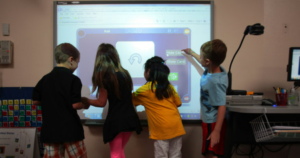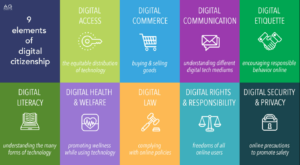Digital Citizenship is the continuously developing norms of appropriate, responsible, and empowered technology use. (Ribble, 2023). Everyone who has access to technology and social platforms has a responsibility to use their technology appropriately. We all actively interact on the internet every day – saving and sending Instagram reels, liking TikTok’s, commenting on Facebook groups, etc. We also censor what we say according to what platform or group we are interacting with. Most of us learned to do this as the technology and platforms we used were gaining popularity, so we always knew how to navigate them. However, as time goes on, younger people grow up and begin using technology in a world where many people scorn the thought of children even touching a cell phone. So how can we, as the influencers and teachers of these students, help them learn how to navigate digital citizenship?
Two Lives or One Life?

The current perspective regarding students and technology is for them to live “two lives;” one as the traditional, unplugged life at school, and a digitally infused one outside of school. (Ohler, 2011). The two lives perspective is, although achievable, unrealistic by today’s standards. To have the students be completely unplugged at school is hypocritical, as most school sources, especially the higher the grade gets, are completely immersed in technology. Essays, tests, and assignments were done vastly through or accompanied by technology when I was in high school, and the influence of these practices travel lower into elementary grades as teachers use YouTube videos or apps to aid their lessons. It seems unfair in many student’s and parent’s eyes to allow teachers to implement technology use when they want, even when the school is to be seen as an unplugged area.
This brings into place the implemented phone bans in schools due to student cell-phone use skyrocketing after COVID-19. These phone bans, even when enforced with fierce consequences going against the ban, have only created sneaky students. Many students these days hide their phones in their bags, going off to the bathrooms to check Snap Chat or Insta Stories. Even then, most kids get phone upgrades, and can put fake phones in the bin at the start of class. Ultimately, the phone ban is unnecessary, and even when enforced is not followed without student rebellion.
This is where a “one life” perspective comes into play. The one life perspective is where we allow students to have an integrated life by inviting technology into school, and talking about it in context of a community. Teaching students how to healthily manage their technological lives and balance it with their realities is essential in creating intelligent adults out of these students. Our world is changing, along with it, technology and its impact on people’s lives. As educators, it is our responsibility to teach the students safety regarding technology.
The Nine Elements of Digital Citizenship

The Nine Themes of Digital Citizenship are designed to lead and assist others in building positive digital experiences while recognizing that actions have consequences to others and allowing participation in a manner for common good. The nine elements are:
- Digital Access
- Digital Commerce
- Digital Communication and Collaboration
- Digital Etiquette
- Digital Fluency
- Digital Health and Welfare
- Digital Law
- Digital Rights and Responsibility
- Digital Security and Privacy
Teaching students these elements will ensure their ability to interact and be a positive member of Digital Citizenship. Focusing at least one lecture on each of the themes is vital to prepare students for social media interactions. Approaching the areas can be done in a number of ways, and ensuring the students get on the right track and understanding of these themes can be discovered through the Digital Citizenship Continuum. One way, of many, that we can teach students the importance of any of the themes, say for example Rights and Responsibilities, is by giving them scenarios that happen every day, such as giving them a sheet of “comments” on a media post and having them cut out and organize them into groups on which comments are respectful and which ones course on cyberbullying or irresponsible. Giving students realistic examples will help them face these situations while navigating technology.
This is a well-researched and insightful discussion on digital citizenship! Your breakdown of the “two lives” vs. “one life” perspective is particularly compelling—acknowledging the reality that technology is already deeply integrated into students’ lives rather than enforcing impractical bans. The emphasis on education over restriction is crucial, and your example of using real-world scenarios to teach digital rights and responsibilities is a great practical approach. The Nine Elements of Digital Citizenship provide a solid framework for guiding students toward responsible and ethical technology use. This is an important conversation for educators, and your post contributes meaningfully to it!
Thank you! With all the recent phone bans in not only elementary schools (which I agree with) but in high schools as well is simply not effective with this generation! They thrive on technological use and should be trained to use it beneficially.
Teaching students how to use technology responsibly rather than banning it makes so much sense. I also agree that teaching the Nine Elements of Digital Citizenship is important, students need these skills to navigate the digital world safely and responsibly.
Yes! Banning it only makes the students want to use it more and they become sneaky with how they incorporate it into school!
Hi Carys, Your post makes a strong case for integrating digital citizenship into education rather than enforcing restrictive policies. The discussion on phone bans is especially relevant, and your breakdown of the Nine Elements is clear and useful.
Thank you! The phone bans is something I’ve been keeping up with as it has started to be implemented in the high school my mom works at. All it does is make students aggravated and find ways to incorporate it sneakily!
Technology is such a big part of students’ lives that it makes sense to teach them how to use it responsibly. Also, teaching the nine elements of digital citizenship is key to helping students understand both their rights and responsibilities online. I really liked your idea of organizing “comments” on a social media post; great idea!